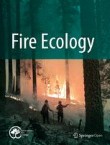Fire Ecology is the official journal of the Association for Fire Ecology.
Post-wildfire recovery of an upland oak−pine forest on the Cumberland Plateau, Kentucky, USA
Many forests within the southern Appalachian region, USA, have experienced decades of fire exclusion, contributing to regeneration challenges for species such as oaks (Quercus spp. L.) and pines (Pinus spp. L.), ...
